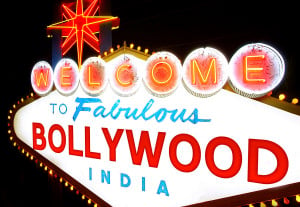If you’ve been keeping up with world happenings for more than five minutes, you might be aware of Bollywood’s presence in modern cinema.
The Hindi-language film behemoth rakes in enough revenue to make it the biggest film industry in the world, beating out Hollywood by almost twofold. Its steadfast fan base is not only prominent across India, but spans well across the globe.
And if you’ve been keeping up with Bollywood films, you might be aware of women’s overtly sexual presence in them. Somewhere between the lavish dance numbers and storylines, women regularly seem to be accessorizing the arm of a man, donning clothing and a personality both made with minimal layers.
Bollywood’s women master the trifecta of acting, dancing, and beauty; pairing such versatile characteristics with an overt display of bodies, it’s easy to assume sexual confidence is, by default, packaged in the image of liberation.
Yet in actuality, sexuality is only permissible when it’s puppeteered by the male gaze – flaunted on screen and silenced off.
At times, this brings me to an impasse – because Bollywood was present throughout much of my childhood. I learned how to speak Hindi as a product of Hindi movie nights with my family – and if you’ve ever heard me speak Hindi, it explains the accidental slip of casual street slang in my words.
Bollywood is an experience in and of itself: Its reels are rife with vibrant colors and culture, often yielding coherent plots to enjoyably absurd escapism. It’s unlikely to view a Hindi film in a theater without undeniable audience participation, cheering for its protagonists, cursing at antagonists, and gasping if one ever turns into the other (a trademark Bollywood plot twist).
Excavating the flaws of Bollywood seems akin to an ideological argument with a parent. I’ve grown up regarding the films as a universal portal to both understanding society and escaping from it, but sometimes the truths we’ve been socialized to accept as children can be unveiled as flawed upon reaching adulthood.
And the problem I’ve come to notice with female characters in Bollywood, unlike Hollywood, is not that there is a dearth of them who look like me (aesthetics aside, of course, because that tends to be synthetic). It’s that women are portrayed as excruciatingly one-dimensional – namely, as subordinately sexual.
Bollywood men, on the other hand, are often seen as overtly machismo with an appetite for dominance, especially over women. And Indian society is patriarchal enough to foster an environment in which boys can emanate these characters as viable role models. Ultimately, it’s men who have the upper hand in women’s sexuality, pining for it and chastising it simultaneously.
Now, I’m not saying that Bollywood is the sole determinant for Indian women’s sexual befuddlement. But with the staggering rate of fans the industry captivates, it could do more to trample the rampant commodification of women.
Women are not only receiving an insulting reflection of their bodies and value in society, but also mind-numbing cognitive dissonance when it comes to navigating their own sexuality.
I understand that the relationship between Bollywood and its actresses opens a Pandora’s box of complicated sexism, such as its perpetuation of rape culture (CW) and a lack of complex female characters. And I understand that Bollywood is actively amending its harmful “exhibition” of women with a recent trend in unapologetically badass women in leading roles flexing on the box office.
But right now, I want to dig into just how paradoxical female sexuality is, according to Bollywood. The patriarchy in most countries has its own uniquely tailored ways to infringe on women’s sexual expression, yes. In this instance, I want to discuss how Bollywood particularly influences South Asian women.
So here are few of the harmful ways it does.
1. It Perpetuates Harassment
There’s a generationally consistent staple of Bollywood called the item song, which at its foundation is a vivacious musical performance in a film, often completely irrelevant to the plot, that might support the film’s marketability.
The song is almost always spearheaded by a single hypersexualized female dancer who sings about how unattainable she is, while surrounded by hundreds of sartorially homogenous male “dancers” twitching their heads demonically at her bosom.
Countless actresses have cameoed as “item girls” and appeared in a movie just for that one song – which, of course, is their discretion. But the constant message of playing hard-to-get, as well as generally condoning men’s whistling, seems to translate into a free pass for IRL harassment.
It’s impossible to control how these images are perceived, even if the women in them exercising their own freedom of choice in a male-dominated and driven industry. It desensitizes consent by brainwashing men into thinking a woman’s dressing choice is directly correlated to her wanting sex, and it brainwashes women into thinking they have to act a certain way to attract a man’s attention.
Women are never asking for it, whether they’re dancing in short saris or are just walking to a destination, and Bollywood seems to dig up sexualization in situations where women are just trying to live their lives (because according to movies, these ladies aren’t fulfilled unless they have a man).
So, if sex is so coveted in Indian film, one would assume the act, as well as the emotions behind it, are properly depicted. Right?
Not exactly.
The hyper sexualization of women – from wearing minimal clothing to close-up butt shots to even getting caught in a surprise waterfall – is endless, yet kissing and nudity (that isn’t for objectification purposes) are fervently shunned.
These films teach women that they’re given a code of conduct, yet punished if it’s to be acted upon. In a way, what we consider female sexuality in Bollywood is not really about sex – it’s more about objectification and pandering to a false expectation of masculinity.
A 14-minute video titled “No Country for Women” (CW: sexual harassment, assault) digs into common tropes of Bollywood’s women and connects them to incidences of sexual harassment and brutality towards women.
One interviewee, a male passerby, even remarked that if “women on the street are dressed showing off their body [like the actresses in the movies], how could we not hit on them?”
This video sums up how Bollywood overlooks men imitating actors and expecting acknowledgement for their inflated dominance, yet if a woman dares to dress the way she wants – sans imitation – she’ll get harassed and treated reductively. It’s honestly frightening.
2. It Blocks Open Conversation About Sexuality
Among Indian women, chastity is king. Especially in rural areas, women are expected to aspire only towards marriage, and virginity is vital.
Many Indians have a negative opinion of “urbanized” women who, by living in bigger cities and therefore conducting their lives under the Western sphere of influence and freedom, are seen as too provocative.
Which essentially goes to show that the same men drooling over item songs are the same who harbor disrespect for the song’s main dancer as a person.
The discrepancy and general misunderstanding of sex stems from a general avoidance of the whole topic. Indian society is notorious for shunning the topic of sex, but when people do bring it up, it’s either to reprimand against it or just feign ignorance until their child is married.
And this isn’t only an age-old epidemic in India – I have friends in the US, Canada, UK, and in other Western cultures where sex revulsion was sustained through their parents’ immigration and then regurgitated onto them.
I can’t even count the number of stories I’ve heard wherein couples dated for years without their parents knowing, or else they lived together in an arrangement where one would skip town and rid the apartment of any evidence when the other’s parents were visiting.
Parents of daughters are especially harsh. I can clearly remember my parents shielding my eyes at even the semblance of a kiss about to take off, yet numerous instances of objectification are permanently etched in my mind, even before I was aware of their harm.
This is a textbook example of sexual hypocrisy, whereby female sexuality seems to be exercised by those consuming it – namely, as an entertainment form – rather than by those who own it.
As a child, I was given a code of behavior way before I even knew what to do with it; as an adult, said code resulted in more harm than hurt. I won’t try to hide the times in my life, especially as a teen, where I thought to dress for others over myself in an effort to gain romantic attention. Today, I know how I dress really means nothing except for the fact that I am a human person with discretion over her wardrobe choices – a great wardrobe, in my humble opinion.
What further complicates sexuality is the lack of LGBTQIA+ representation in Indian cinema. Homosexuality is still considered a crime in India, and some films with queer subject matter still encounter hurdles in production and distribution – although conversations surrounding it are slowly getting more favorable.
Indian society is quite traditional, which makes the juxtaposition of chastity and sexual provocation so profitable for Bollywood.
Off screen, conversations surrounding even heteronormative sexuality are so repressed that it barely allows for the mainstream representation of LGBTQIA+ relationships. There is definitely a long way to go in humanizing the community, although Hindi films from Bollywood’s burgeoning indie scene give us hope.
3. It’s Historically Inaccurate
India is one of the oldest civilizations in the world, and it has changed in myriad ways over the years. While I cannot do justice for every single religious, scientific, artistic, or economic paradigm shift that’s occurred in the last few centuries, I do want to focus on just how much the collective mindsets on sexuality have changed within the context of history.
Let’s start at the foundation of Indian culture, which, like most modern societies, began with religion.
A key concept of Hinduism, India’s oldest and largest religion, includes the four main goals of human life, one of which is called kama. Kama refers to any desire, passion, or love vital to attaining a fulfilling life experience. In contemporary literature, kama often connotes sexual desire and is considered a necessary and healthy goal when pursued without sacrificing the three other goals. (Sounds familiar? It is the prefix of kamasutra.)
That is to say, India was historically accepting of the body and its desires in all its nuanced forms. Non-provocative nude statues were commonly constructed in and around places of worship; though many continue to exist today, mindsets towards sex as a natural part of life have become increasingly narrower.
Within the earlier invasion of Islamic forces and upon the onset of British colonialism, India’s outlook on the roles of race, gender, and sexuality meshed to fit under the more conservative mold of Abrahamic religions. Colonialism further dwindled power to the hands of a select few and gender roles adhered to its environment rather than religion.
Which is all a bit ironic, considering today’s British are part of the broader Western mindset that, today, Indians view as too sexually open.
That is to say, Hinduism, at some part of its core, regards sex as integral – and yet, society today views it as taboo. Bollywood, in this manner, markets through shock value by tapping into a primal need — and that’s why it sells so well.
Yet it’s interesting to see how religion has influenced society, which in turn, influences entertainment – all like a convoluted game of telephone. For example, many regions and households practicing Hinduism regularly worship the pancha kanyas, directly translated as “five virgins.” These goddesses, ironically, were the beacons of modern sexual freedom in that they had different partners and even had one-night stands.
Although, their being regarded as virgins says a lot about how society hails virginity in women: The same people who are worshipping the sanctity of the goddesses are probably equally enjoying their crassly open representation in Bollywood. Of course, it’s seen as strictly cinematic and shunned against if ever imitated.
As writer Aswini Anburajan pointed out for Buzzfeed, the mindset of a woman’s virginity equating her dignity can be traced back even earlier than the pancha kanyas, starting at the Indian myth of Ramayana. Ramayana’s wife, Sita, was forced to walk through fire to prove she was still chaste after being kidnapped by a foe king.
Going back to the shock value in cinema, women are sacrificing a sexual, historically sanctioned sexual acumen for mass ticket sales. We are offered a clearer representation in history, yet blocked from its access.
I often wonder whether or not to shoot the messenger, considering entertainment is a reflection of society – yet the industry is large enough for both to be representations of each other.
***
Indian cinema is gargantuan and rooted in a culture of traditionalism. Our generation is parlaying positive change, but it’s going to take a while for modern, social injustices to be rightly acknowledged and reflected on-screen.
Optimistically I can say it’s unlikely that Indian films have been, and always will be, stuck in a sexist rut. Films like Kahaani, Rani, and English Vinglish, to name a few, have both featured strong female leads and have seen significantly strong performance at the box office. There’s this list on getting the “masala” of Bollywood without the misogyny. And this one on its many strong women. And this one of movies having somewhat of a conscience of its injustices, dating back to even the 60s. Sometimes, it’s just a matter of getting the right voices the recognition they deserve.
The film industry as a whole is not to blame. India is full of talented artists in all regards, who care about diversity and all-around respectfulness in their art, and I truly believe their work will gain the mainstream recognition it deserves.
In the meantime, we should at least be cognizant of the expectations a woman carries of her body and sexuality on-screen versus off.
The ideal woman is expected to be coy, naive, and mysterious, while Westernized or modern women are portrayed as so free that they have basically given their consent to anything a man might want to do to them, without even considering their autonomy.
In the end, it’s always the coy, shy, virginal girl who wins their hearts over with her innocence. But she still isn’t seen as much more than a prize.
We’re hoping the right voices will be broadcasted into the mainstream eventually, but having the influence they do, they could do more to set the standard of how women are portrayed – showing that they are beings with their own agency and are not the property of men.
[do_widget id=’text-101′]
Nikita Redkar is a Contributing Writer for Everyday Feminism. She is a freelance writer in New York City who currently interns for Fusion Network where she writes about diversity in pop culture and how it’s shifting the current landscape of racial and gender politics. When she’s not writing, she is taking classes in sketch comedy and reading bizarre astronomy theories. She likes cute animal gifs and dislikes long walks on the beach, plagues, and other cliches.
Search our 3000+ articles!
Read our articles about:
Our online racial justice training
Used by hundreds of universities, non-profits, and businesses.
Click to learn more





















